1.Bipolar disorder is a serious brain disorder in which a person experiences extreme variances in thinking, mood, and behavior.
2. Bipolar disorder is also sometimes called manic-depressive illness or manic depression.
3.People who have bipolar disorder commonly go through periods of depression or mania. They may also experience frequent mood swings.
4.Over 2 percent of Americans will develop bipolar disorder.
5.Symptoms of bipolar disorder show themselves in people's energy, activity levels, sleep patterns and behaviors.
6.Bipolar disorder often results in poor job performance, trouble in school, or damaged relationships.
7.People who have very serious, untreated cases of bipolar disorder sometimes commit suicide.
8.People with bipolar disorder experience intense emotional states referred to as "mood episodes."
9. Symptoms of a depressive mood episode may also include:
• feelings of emptiness or worthlessness
• loss of interest in once pleasurable activities such as sex
• behavioral changes
• fatigue or low energy
• problems with concentration, decision-making, or forgetfulness
• restlessness or irritability
• changes in eating or sleeping habits
• suicidal ideation or a suicide attempt
10.On the other extreme side of the spectrum are manic episodes. Symptoms of mania may include:
• long periods of intense joy, excitement, or euphoria
• extreme irritability, agitation, or a feeling of being "wired" (jumpiness)
• being easily distracted or restless
• having racing thoughts
• speaking very quickly (often so fast others are unable to keep up)
• taking on more new projects than one can handle (excessively goal directed)
• having little need for sleep
• unrealistic beliefs about one's abilities
• participating in impulsive or high-risk behaviors such as gambling or spending sprees, unsafe sex, or making unwise investments
11.Some people with bipolar disorder may experience hypomania. Hypomania means "under mania" and symptoms are very similar to mania, but less severe.
12.The exact cause of bipolar disorder is unknown, but several factors may be involved, such as:
• Biological differences. People with bipolar disorder appear to have physical changes in their brains. The significance of these changes is still uncertain but may eventually help pinpoint causes.
• Neurotransmitters. An imbalance in naturally occurring brain chemicals called neurotransmitters seems to play a significant role in bipolar disorder and other mood disorders.
• Inherited traits. Bipolar disorder is more common in people who have a first-degree relative, such as a sibling or parent, with the condition. Researchers are trying to find genes that may be involved in causing bipolar disorder.
13.Bipolar disorder cannot be cured. It is considered a chronic illness, like diabetes, and must be carefully managed and treated throughout your life. Treatment usually includes both medication and therapies, such as cognitive behavioral therapy.
14.Medications used in the treatment of bipolar disorders include:
• mood stabilizers such as lithium (Eskalith or Lithobid)
• atypical antipsychotic medications such as olanzapine (Zyprexa), quetiapine (Seroquel), and risperidone (Risperdal)
• anti-anxiety medications such as benzodiazepine are sometimes used in the acute phase of mania
• anti-seizure medications (also known as anticonvulsants) such as divalproex-sodium (Depakote), lamotrigine (Lamictal), and valproic acid (Depakene)
• People with bipolar disorder will sometimes be prescribed antidepressants to treat symptoms of their depression, or other conditions (such as co-occurring anxiety disorder). However, they often must take a mood stabilizer, as an antidepressant alone may increase a person's chances of becoming manic or hypomanic (or of developing symptoms of rapid cycling).
B










Yorumlar
Yorum Gönder